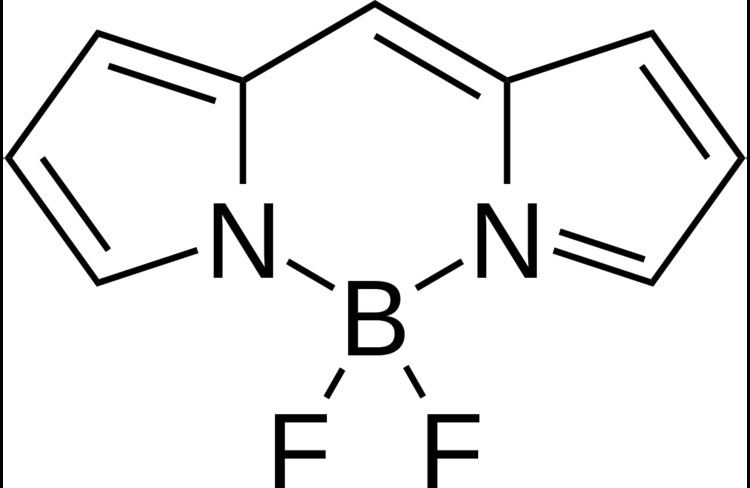 | ||
BODIPY, abbreviation for boron-dipyrromethene, is a class of fluorescent dyes. It is composed of dipyrromethene complexed with a disubstituted boron atom, typically a BF2 unit. The IUPAC name for the BODIPY core is 4,4-difluoro-4-bora-3a,4a-diaza-s-indacene. Due to instability of the required unsubstituted dipyrromethene precursor, the unsubstituted BODIPY dye had not been prepared until 2009. Three independent groups reported different syntheses of the title compound.
Contents
Properties
BODIPY dyes are notable for their uniquely small Stokes shift, high, environment-independent fluorescence quantum yields, often approaching 100% even in water, sharp excitation and emission peaks contributing to overall brightness, and high solubility in many organic solvents. The combination of these qualities makes BODIPY fluorophore an important tool in a variety of imaging applications. The position of the absorption and emission bands remain almost unchanged in solvents of different polarity as the dipole moment and transition dipole are orthogonal to each other.
Synthesis
BODIPY are prepared by reacting a dipyrromethene precursor with boron trifluoride etherate in the presence of a tertiary amine, usually triethylamine. Dipyrromethenes are accessed from a suitable pyrrole, by several methods. Normally, one alpha-position in employed pyrroles is substituted and the other is free. Condensation of such pyrrole, often available from Knorr pyrrole synthesis, with an aromatic aldehyde in the presence of TFA gives dipyrromethane, which is oxidized to dipyrromethene using a quinone oxidant such as DDQ or p-chloranil.
Alternatively, dipyrromethenes are prepared directly by reacting a pyrrole with an activated carboxylic acid derivative, usually an acyl chloride. Unsymmetrical dipyrromethenes can be obtained by condensing pyrroles with 2-acylpyrroles. Intermediate dipyrromethanes may be isolated and purified, but isolation of dipyrromethenes is usually compromised by their instability.
Structures
Some structures of commonly used BODIPY fluorophores.
Applications
Applications include the use of cadmium-selective probes, based on BODIPY, to image and sense cadmium in cells and labeling oligonucleotides for sequencing
